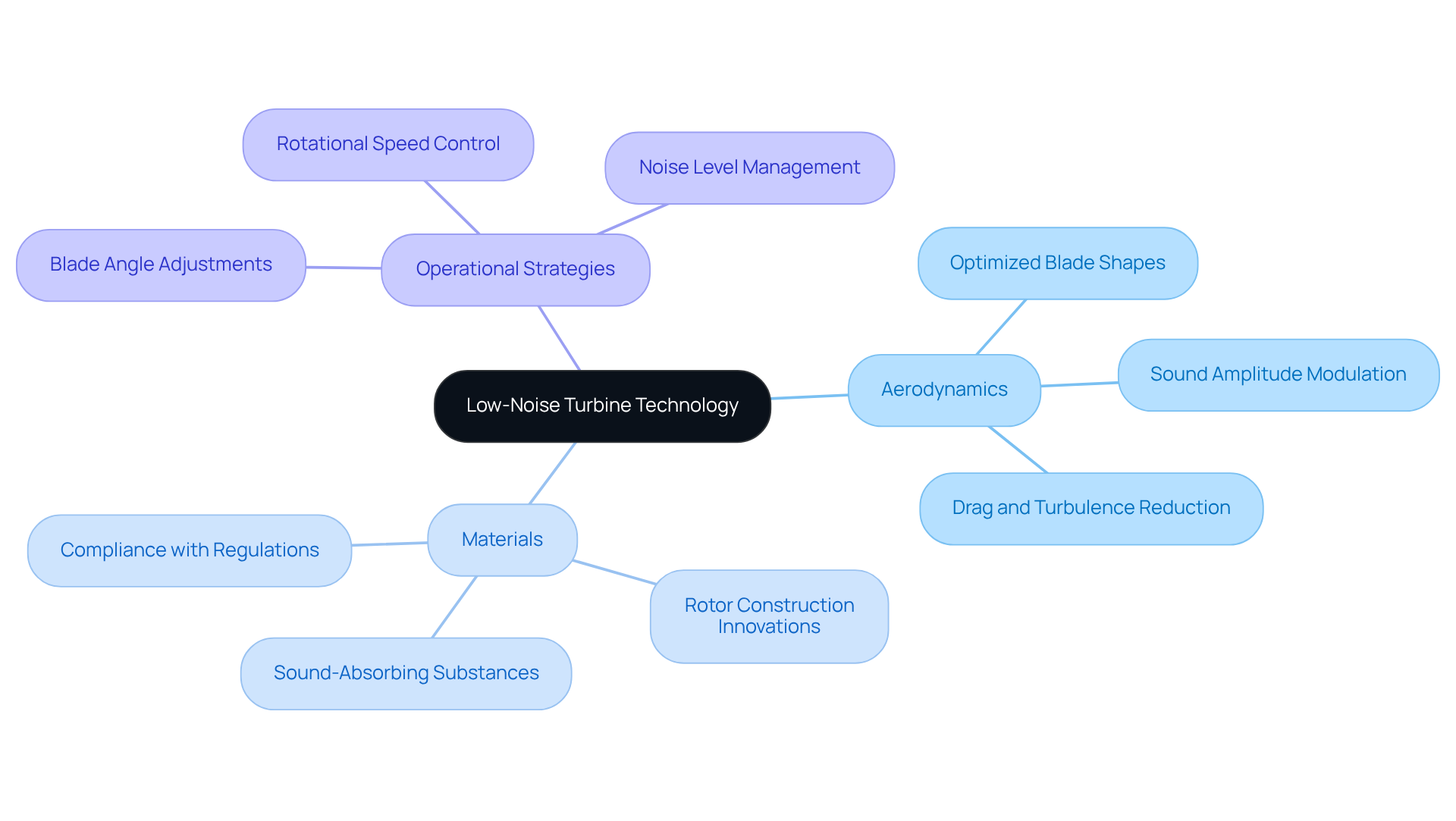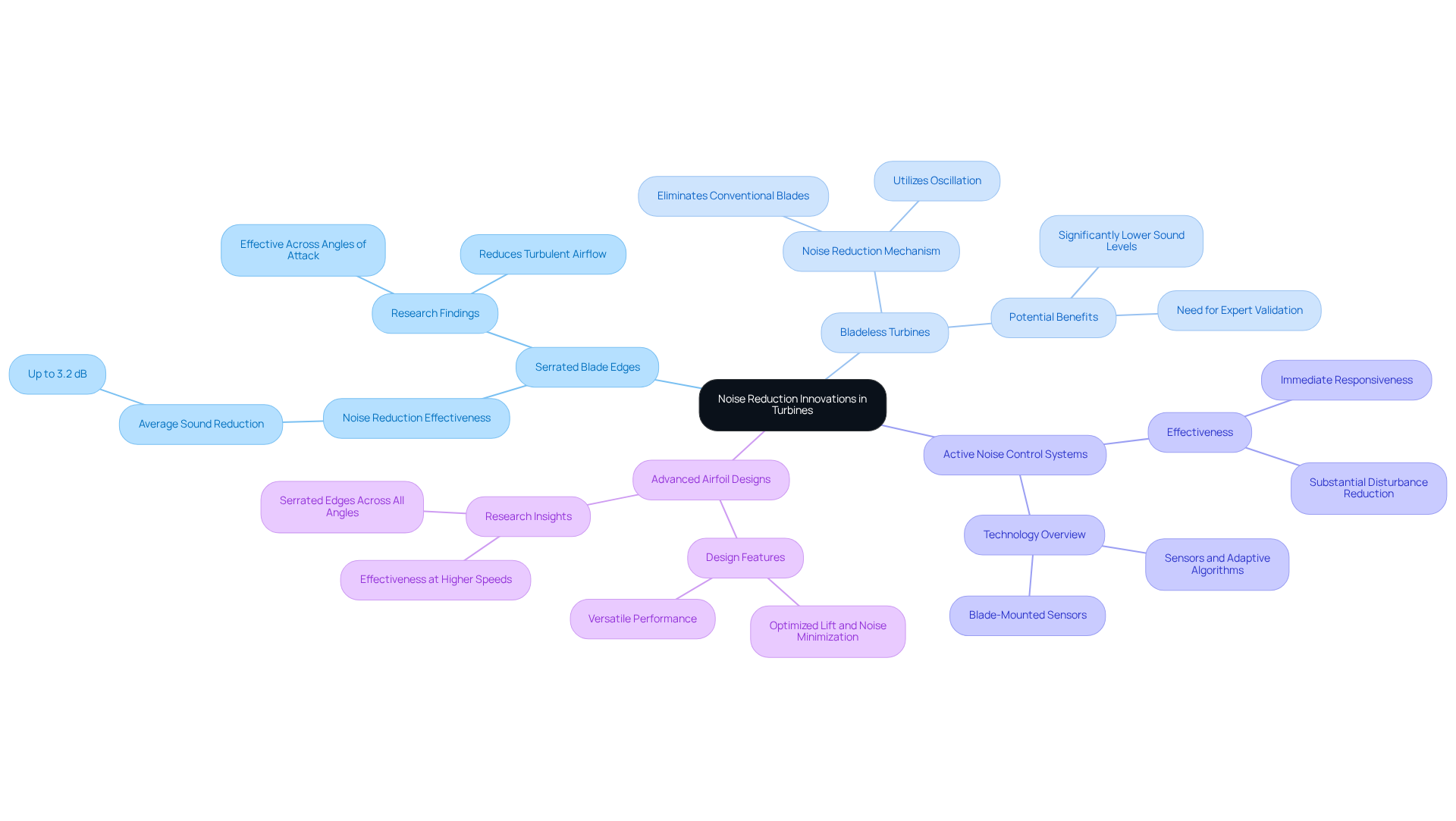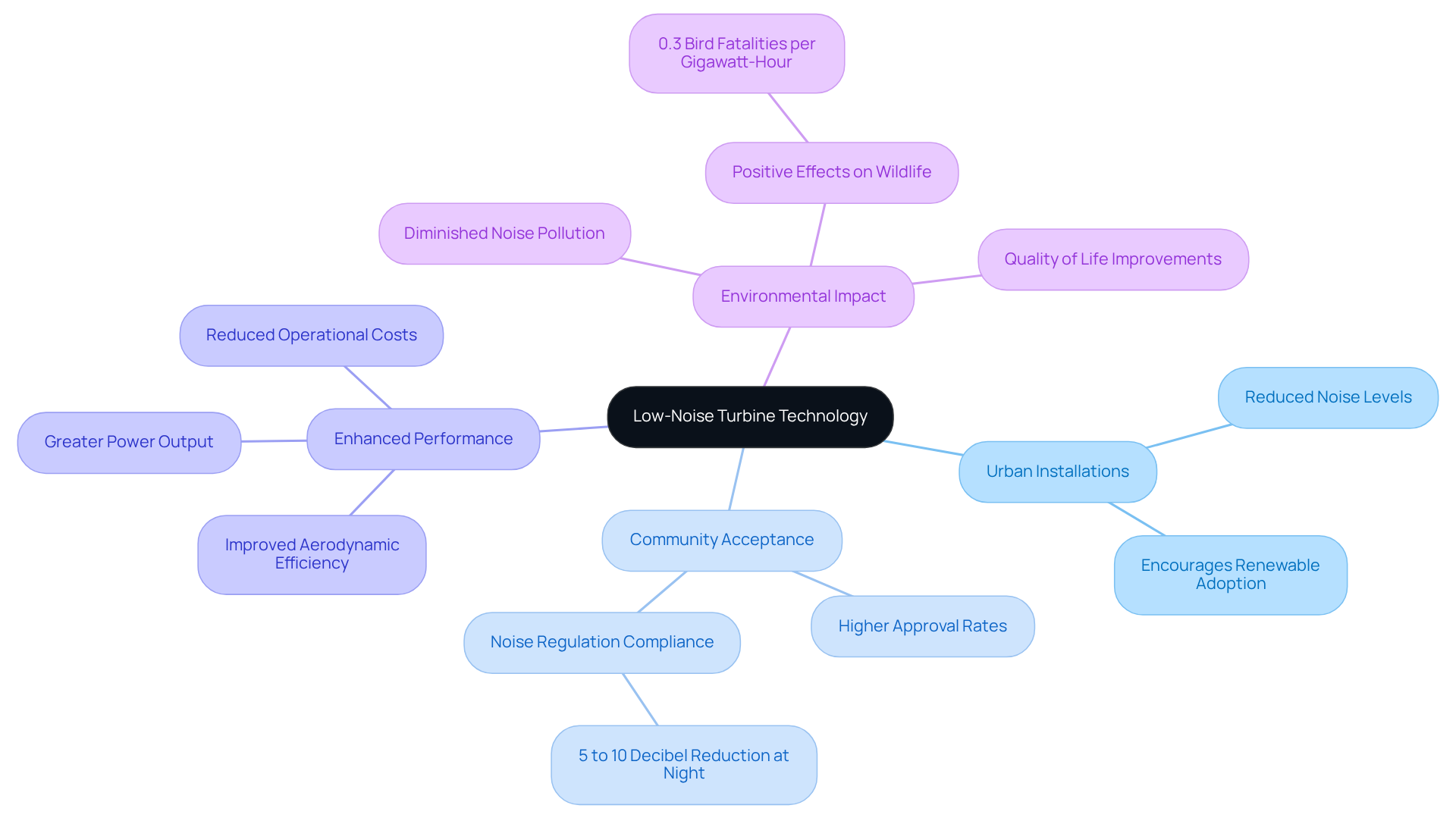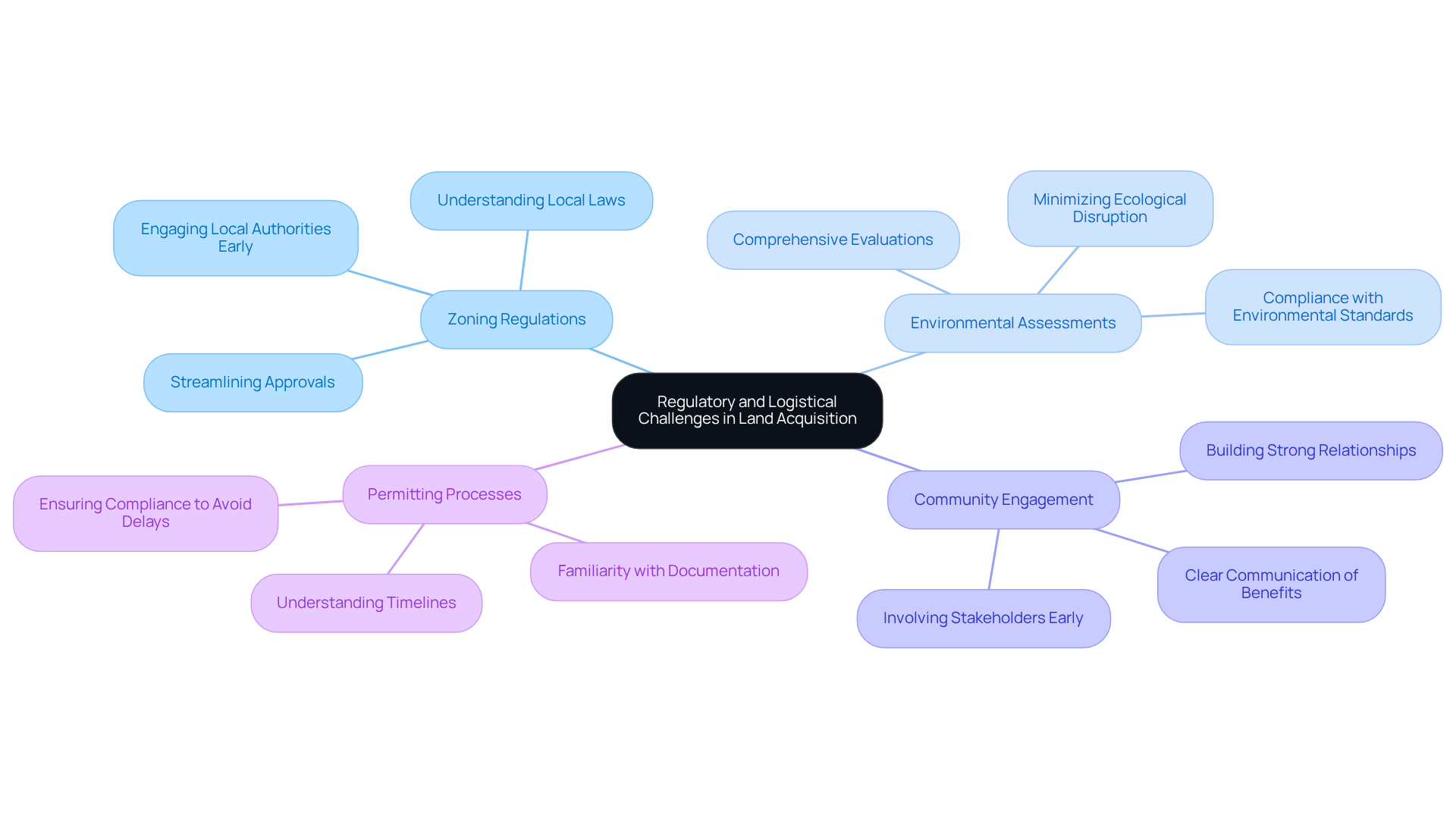Overview
Low-noise turbine technology represents a significant advancement in reducing sound emissions while enhancing energy efficiency. By leveraging advanced aerodynamics, innovative materials, and strategic operational practices, this technology addresses a critical issue: noise pollution.
Features such as:
- Optimized blade designs
- Sound-absorbing materials
not only diminish noise but also bolster community acceptance and performance. Consequently, wind energy emerges as a more viable option for urban environments, paving the way for sustainable energy solutions.
Introduction
The pursuit of sustainable energy solutions has catalyzed significant advancements in turbine technology, particularly in the development of low-noise turbines. These innovative designs are not only reducing sound emissions but also enhancing energy efficiency, thereby transforming the renewable energy landscape. As urban areas confront the pressing issue of noise pollution, the integration of low-noise turbine technology offers a distinct opportunity to align energy production with community well-being.
Yet, how can stakeholders effectively navigate the intricate challenges of design, community acceptance, and regulatory frameworks to fully harness the advantages of this promising technology?
Explore the Fundamentals of Low-Noise Turbine Technology
Low-noise turbine technology is engineered to significantly reduce sound emissions while improving energy efficiency. Conventional wind generators primarily generate noise from blade rotation and aerodynamic interactions. In contrast, low-noise turbine technology utilizes advanced airfoil shapes and innovative materials to minimize turbulence and vibration, resulting in quieter operation. Key concepts include:
- Aerodynamics: Mastering airflow over turbine blades is essential. Low-noise turbine technology often incorporates optimized blade shapes that effectively reduce drag and turbulence, enhancing overall performance. For instance, amplitude modulation of wind generator sound varies at the blade pass rate, typically between 0.5 and 2 Hz, which can influence community perception of sound.
- Materials: The incorporation of sound-absorbing substances in rotor construction can lead to substantial reductions in sound levels, contributing to a more harmonious integration with surrounding environments. Danish regulations specify permitted indoor sound levels of 20 dBA in the range of 10-160 Hz, underscoring the importance of material choices in meeting community standards.
- Operational Strategies: Adjusting the angle and rotational speed of blade components enables improved control of sound emission, particularly during strong air conditions when sound levels can surge. It is crucial that the permitted turbine sound level at residences does not exceed 35 dBA, which is vital for adherence and community approval.
By understanding these essential concepts, stakeholders can fully appreciate the advancements in generator design that incorporate low-noise turbine technology, aimed at reducing sound pollution, especially in urban areas where community concerns about auditory disturbances are increasingly significant. As Ed Begley, Jr. remarked, "The two most abundant forms of power on earth are solar and wind, and they're getting cheaper and cheaper," emphasizing the necessity of advancing technologies that render wind energy more accessible and environmentally friendly.

Examine Design Innovations for Noise Reduction
Recent innovations in turbine design have concentrated on low-noise turbine technology to reduce noise through various methods.
-
Serrated Blade Edges: The addition of serrations to the trailing edges of blades disrupts airflow patterns, resulting in a notable reduction in noise levels, particularly in the mid-to-high frequency range. Research indicates that these modifications can achieve average sound reductions of up to 3.2 dB, which is essential for minimizing disturbances in surrounding communities.
-
Bladeless Turbines: By eliminating conventional blades and utilizing oscillation to generate energy, these designs significantly lower sound levels. While the potential of bladeless technology is evident, incorporating expert opinions or statistics could further substantiate this point.
-
Active Noise Control Systems: Some wind generators now feature sensors and adaptive algorithms, such as blade-mounted sensors, that actively adjust blade angles and speeds to minimize sound during operation. This immediate responsiveness allows for substantial disturbance reduction, particularly in fluctuating air conditions.
-
Advanced Airfoil Designs: New airfoil shapes are engineered to optimize lift while minimizing sound generation, facilitating quieter operation even at higher speeds. The effectiveness of serrated trailing edges across all tested angles of attack underscores the versatility and reliability of this technology in diverse operational conditions.
These design advancements not only enhance the performance of aerial machines but also utilize low-noise turbine technology to address community challenges related to sound pollution, making renewable power a more viable option in urban environments.

Assess Practical Applications and Benefits of Low-Noise Turbines
Low-noise turbine technology presents a multitude of practical applications and benefits that significantly enhance its viability across various settings.
-
Urban Installations: The reduced noise levels of low-noise turbine technology render them ideal for urban environments, where traditional turbines often face resistance due to noise concerns. This flexibility allows for the incorporation of atmospheric power in densely populated regions, thereby encouraging the adoption of renewable resources.
-
Community Acceptance: By employing low-noise turbine technology to minimize sound pollution, these turbines foster increased community support for wind initiatives. Studies reveal that projects employing low-noise turbine technology experience higher approval rates, facilitating smoother project development and mitigating opposition from local residents. Notably, noise levels are strictly regulated, with reductions of 5 to 10 decibels at night, significantly enhancing community endorsement.
-
Enhanced Performance: Low-noise turbine technology typically results in improved aerodynamic efficiency, leading to greater power output and reduced operational costs. This efficiency benefits project developers while simultaneously bolstering the overall sustainability of renewable initiatives.
-
Environmental Impact: Low-noise turbine technology in quieter generators substantially diminishes noise pollution, positively influencing local wildlife and enhancing the quality of life for nearby residents. Research indicates that wind power results in only 0.3 bird fatalities per gigawatt-hour, compared to 5.2 for fossil fuels, aligning with environmental protection objectives and ensuring that wind projects coexist harmoniously with their surroundings.
These applications illustrate how low-noise turbine technology effectively addresses energy requirements while alleviating environmental concerns, paving the way for greater acceptance and implementation of renewable energy solutions.

Navigate Regulatory and Logistical Challenges in Land Acquisition
Navigating the regulatory and logistical challenges in land acquisition for projects involving low-noise turbine technology presents several critical considerations.
- Zoning Regulations: Local zoning laws dictate permissible locations for turbine installations, making their understanding essential. Engaging with local authorities early in the planning process can help identify potential issues and streamline approvals. Harbinger Land's expertise in site and right-of-way acquisitions ensures meticulous adherence to all zoning regulations, facilitating smoother project execution.
- Environmental Assessments: Comprehensive environmental evaluations are often required to assess the impacts of installation on local ecosystems and wildlife. These assessments are crucial for ensuring compliance with environmental standards and minimizing ecological disruption. Harbinger Land's advanced title research solutions support these assessments by providing accurate land data, ensuring that environmental considerations are fully integrated into the planning process.
- Community Engagement: Strong relationships with local communities are vital for mitigating opposition and fostering project support. Clear communication regarding the advantages of low-noise turbine technology, such as reduced noise pollution and ecological benefits, can enhance community backing. Successful examples of community involvement in low-noise turbine technology projects illustrate that when stakeholders are engaged early and kept informed throughout the process, these projects are more likely to receive local support and achieve timely approvals. Harbinger Land's commitment to community engagement is reflected in its thorough approach to land rights acquisition, ensuring that local voices are heard and considered.
- Permitting Processes: Familiarity with the permitting process at local, state, and federal levels is crucial. Understanding the necessary documentation and timelines involved is essential, as these can vary significantly depending on the jurisdiction. Non-compliance with local zoning regulations can lead to project delays, financial penalties, or outright denials, underscoring the importance of navigating these processes effectively. Harbinger Land's efficient document imaging solutions streamline title research and leasing, enabling quicker access to necessary documentation and facilitating compliance with permitting requirements.
By proactively addressing these challenges, project developers can streamline the land acquisition process, ensuring that low-noise turbine technology projects are implemented efficiently and effectively, supported by Harbinger Land's comprehensive services.

Conclusion
Low-noise turbine technology signifies a pivotal advancement in renewable energy, prioritizing the reduction of sound emissions while enhancing efficiency. By utilizing innovative aerodynamic designs, sound-absorbing materials, and sophisticated operational strategies, this technology not only boosts the performance of wind turbines but also alleviates community concerns regarding noise pollution. The incorporation of these features positions low-noise turbines as an appealing solution for urban areas, where conventional wind generators often encounter opposition.
Key insights into low-noise turbine technology reveal the critical role of design innovations, such as serrated blade edges and bladeless turbines, in achieving lower noise levels. Additionally, the implementation of active noise control systems facilitates real-time adjustments that substantially lessen sound disturbances. These technological advancements not only foster greater acceptance of wind energy projects within communities but also enhance operational efficiency and environmental sustainability.
Ultimately, the progress in low-noise turbine technology highlights the urgent need for renewable energy solutions that align with urban environments and community expectations. As the demand for sustainable energy sources escalates, embracing these innovations will be vital for promoting broader acceptance and successful execution of wind energy projects. Stakeholders are urged to delve deeper into these advancements, ensuring that the transition to renewable energy is both effective and considerate of the communities it serves.
Frequently Asked Questions
What is low-noise turbine technology?
Low-noise turbine technology is designed to significantly reduce sound emissions while improving energy efficiency in wind generators.
What causes noise in conventional wind generators?
Conventional wind generators primarily generate noise from blade rotation and aerodynamic interactions.
How does low-noise turbine technology reduce noise?
It utilizes advanced airfoil shapes and innovative materials to minimize turbulence and vibration, resulting in quieter operation.
What role does aerodynamics play in low-noise turbine technology?
Mastering airflow over turbine blades is essential, with optimized blade shapes reducing drag and turbulence, enhancing overall performance.
What is amplitude modulation in the context of wind generator sound?
Amplitude modulation refers to the variation of wind generator sound at the blade pass rate, typically between 0.5 and 2 Hz, which can affect community perception of sound.
How do materials impact the sound levels of turbines?
The incorporation of sound-absorbing substances in rotor construction can significantly reduce sound levels, aiding in a more harmonious integration with surrounding environments.
What sound levels are regulated in Denmark for indoor environments?
Danish regulations specify permitted indoor sound levels of 20 dBA in the range of 10-160 Hz.
What operational strategies can be employed to control sound emission?
Adjusting the angle and rotational speed of blade components can improve control of sound emissions, especially during strong air conditions.
What is the maximum permitted sound level for turbines at residences?
The permitted turbine sound level at residences should not exceed 35 dBA to ensure adherence and community approval.
Why is low-noise turbine technology important for urban areas?
It addresses community concerns about auditory disturbances, making wind energy more accessible and environmentally friendly, especially in urban settings.
List of Sources
- Explore the Fundamentals of Low-Noise Turbine Technology
- Turbine Quotes (5 quotes) (https://goodreads.com/quotes/tag/turbine)
- Top Ten Quotes about Wind Energy and Windmills (https://solar-us-shop.com/blogs/solar-blog/top-ten-quotes-about-wind-energy-and-windmills?srsltid=AfmBOoqCz67KQ_qEIy_7sq-ToPphyHHQmMiqH6sAv6uqpH5oMtv5ve8b)
- Recent Advances in Wind Turbine Noise Research (https://mdpi.com/2624-599X/2/1/13)
- Wind Turbine Noise Reduction through Blade Retrofitting (https://scirp.org/journal/paperinformation?paperid=133892)
- Examine Design Innovations for Noise Reduction
- Noise Reduction in Wind Turbines (https://xray.greyb.com/wind-turbines/reduce-noise-from-wind-turbine)
- Aerodynamic Performance Analysis of Trailing Edge Serrations on a Wells Turbine (https://mdpi.com/1996-1073/15/23/9075)
- (PDF) Reduction of Wind Turbine Noise Using Optimized Airfoils and Trailing-Edge Serrations (https://researchgate.net/publication/245426588_Reduction_of_Wind_Turbine_Noise_Using_Optimized_Airfoils_and_Trailing-Edge_Serrations)
- Innovative approaches for reducing wind turbine noise: A review from Mechanical and Aerodynamic perspective | Request PDF (https://researchgate.net/publication/387231484_Innovative_approaches_for_reducing_wind_turbine_noise_A_review_from_Mechanical_and_Aerodynamic_perspective)
- Noise Reduction in Wind Turbine Airfoils with Serrated Trailing Edges: An Experimental Study in Low Turbulence Wind Tunnel (https://arxiv.org/html/2307.12188v2)
- Assess Practical Applications and Benefits of Low-Noise Turbines
- Wind energy and the environment (https://windeurope.org/about-wind/wind-energy-and-the-environment)
- Wind Power Quotes: 16 Inspiring Picks (2025) (https://lumifyenergy.com/blog/wind-power-quotes)
- Wind Turbine Noise and Health Study: Summary of Results - Canada.ca (https://canada.ca/en/health-canada/services/health-risks-safety/radiation/everyday-things-emit-radiation/wind-turbine-noise/wind-turbine-noise-health-study-summary-results.html)
- Wind Farms of the Future Will Be More Powerful and Quieter (https://energy.gov/eere/wind/articles/wind-farms-future-will-be-more-powerful-and-quieter)
- Global Statistics (https://wwindea.org/GlobalStatistics)
- Navigate Regulatory and Logistical Challenges in Land Acquisition
- Understanding Local Zoning Compliance for Wind Farms: An In-Depth Tutorial (https://blog.harbingerland.com/understanding-local-zoning-compliance-for-wind-farms-an-in-depth-tutorial)
- By the Numbers - Canadian Renewable Energy Association (https://renewablesassociation.ca/by-the-numbers)
- Wind Power Facts and Statistics | ACP (https://cleanpower.org/facts/wind-power)
- Siting and Permitting Wind Projects (https://stoel.com/insights/reports/the-law-of-wind/siting-and-permitting-wind-projects)




